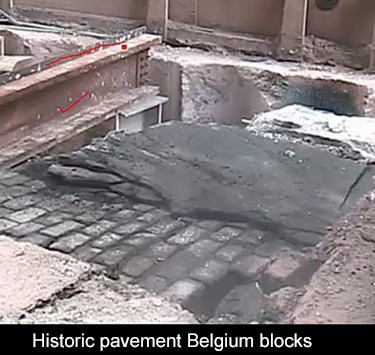This pipe is a fresh air supply for the workspace. You're already familiar with some of the other features. This is a whaler and these are the pipe struts. The whaler is reacting against the existing subway station. Let me just point out one other interesting feature. This arrangement here is probably an existing utility manhole, which is filled with either telephone lines or power lines, and it's virtually impossible to support one of these massive concrete structures by hanging it from the decking.
 What is typically done is that you break out the existing concrete manhole. This must be done with great care. Then, you build a temporary plywood enclosure around the live cables.
What is typically done is that you break out the existing concrete manhole. This must be done with great care. Then, you build a temporary plywood enclosure around the live cables.
We're going to see a video showing exactly how the decking is constructed. The video goes by rather quickly, and I wanted to point out some of the features in advance. This is the starter wall, which is used to guide the drilling equipment for the secant pile wall. This is the same wall that we saw in class number three. The starter wall was not visible because it was always covered with debris or tailings from the drilling. Now, in this photo, you can see it very clearly, and you can see just exactly how controls the shape of the secant
This is one of the steel beams that is inserted in every other hole. Those are the secondary holes. This beam has already been cut down to size, and a steel plate has been attached to it. The steel plate will support the deck beam. This is a deck beam. Let me point out there's this plate attached to the top flange of the decking beam. That serves as a guide for keeping the deck panels in place. This is the scallop-shaped starter wall which guided the drilling process.
 I call these Belgian blocks. A lot of people call them cobblestones, but I like the term Belgium blocks because it gives it a sense of history. These blocks came over from Europe in sailing ships. This practice was in place up until about 200 years ago. These are very old blocks which may very well have come from Belgium or shipped from Antwerp. They served as ballast in the ships. The ships must have come over empty or substantially empty and filled up with material from the new world to be shipped back to the old world. The Belgian blocks were covered over by many later layers of asphalt and then, finally, with concrete.
I call these Belgian blocks. A lot of people call them cobblestones, but I like the term Belgium blocks because it gives it a sense of history. These blocks came over from Europe in sailing ships. This practice was in place up until about 200 years ago. These are very old blocks which may very well have come from Belgium or shipped from Antwerp. They served as ballast in the ships. The ships must have come over empty or substantially empty and filled up with material from the new world to be shipped back to the old world. The Belgian blocks were covered over by many later layers of asphalt and then, finally, with concrete.
This concrete has been removed and probably this is the first daylight that the Belgian blocks have seen in over a century. In this slide, you can see the laborer is very carefully chipping around an existing manhole, because of the degree of care and the rather small tool he's using. I'm sure this manhole is alive and filled with live cables. So, he's a proceeding very, very carefully. It could be that this manhole will now be demolished in place and protected with a plywood structure. Let me just point out, this fellow is standing on the completed deck. These are concrete panels, which cover over the excavation.